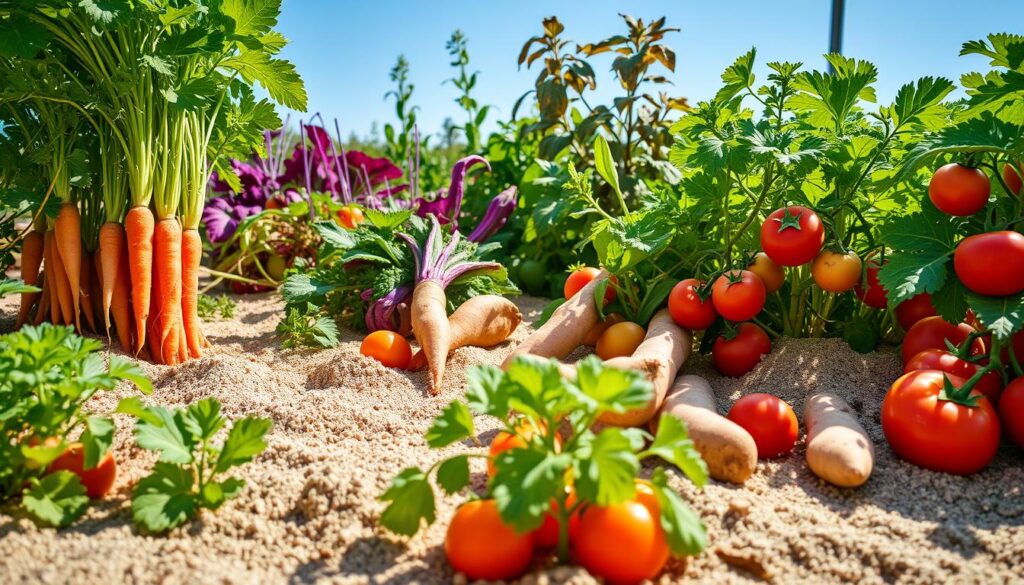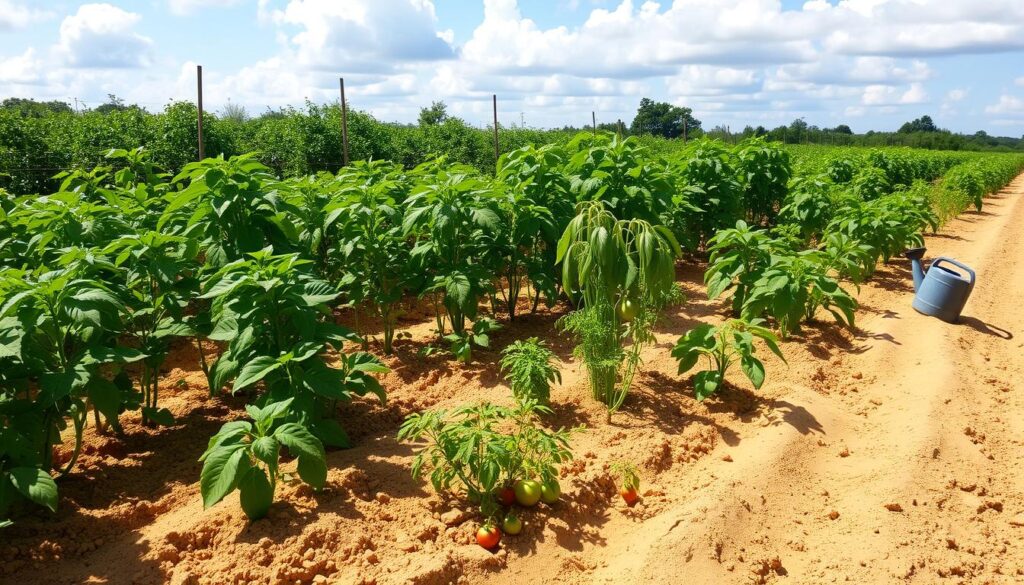As an experienced gardener, I’ve found growing vegetables in sandy soil to be both a challenge and a reward. In this guide, I’ll share my knowledge on how to make even the toughest sandy soil into a garden full of fresh produce.
Whether you’re new to gardening or have years of experience, you’ll find useful tips here. You’ll learn how to make your soil better, pick the best vegetables, and grow a lot of food even in sandy soil. By knowing what sandy soil needs and using smart gardening tricks, you can grow the delicious veggies you’ve always wanted.
Key Takeaways
- Understand the challenges of sandy soil, including nutrient deficiency and poor water retention
- Learn how to prepare sandy soil for successful vegetable gardening
- Discover the best vegetables that thrive in sandy conditions
- Explore organic matter amendments to improve soil quality
- Implement effective irrigation techniques for sandy soil gardens
- Utilize mulching strategies to conserve moisture in sandy environments
- Develop a fertilization plan for optimal vegetable growth in sandy soil
Understanding the Challenges of Sandy Soil
As a vegetable gardener, you’ll face unique challenges with sandy soil. This soil type has properties that make gardening tough. We’ll look at two main issues: nutrient deficiency and poor water retention in sandy soils.
Nutrient Deficiency in Sandy Soils
Sandy soils lack nutrients like nitrogen, phosphorus, and potassium. Their large particles and fast drainage cause nutrients to wash away. This leaves plants hungry and weak, making them more vulnerable to pests and diseases.
Poor Water Retention in Sandy Soils
Sandy soils also struggle to keep water. Their open structure lets water drain fast, leaving plants dry. This means you’ll need to water often, which can stress plants and hurt your garden’s health.
To beat these challenges, you’ll need to focus on managing nutrients and saving water. Next, we’ll show you how to get your sandy soil ready for a successful garden.
“The key to growing vegetables in sandy soil is understanding its unique properties and adapting your gardening practices accordingly.”
Preparing Sandy Soil for Vegetable Gardening
Planning a vegetable garden in sandy soil? Start with good soil prep. The right mix can make your garden flourish. Let’s explore how to get your soil ready for a great harvest.
Enhancing Soil Structure and Fertility
First, make your sandy soil better for growing. It needs organic matter and nutrients. Add sandy soil amendments like compost or coir to the top 8-10 inches. These improve moisture, nutrients, and soil life for your plants.
Improving Water Retention
Sandy soil holds water poorly. Use biochar or vermiculite to help. They soak up water, making it available to your plants. This means less watering and healthier plants.
| Soil Amendment | Benefit |
|---|---|
| Compost | Improves soil structure, increases nutrient levels, and enhances water retention |
| Biochar | Absorbs and stores water, providing a consistent moisture supply for plants |
| Vermiculite | Increases water-holding capacity and improves soil aeration |
By following these steps, you’ll make your sandy soil great for veggies. Next, we’ll talk about picking the best veggies for your garden and keeping it healthy.
“Healthy soil is the foundation for a thriving vegetable garden, and that’s especially true in sandy soils. With the right soil preparation, you can unleash the full potential of your sandy plot.”
Selecting Vegetables Suitable for Sandy Soil
Not all vegetables grow well in sandy soil. But, there are many that can do great in these conditions. As a seasoned gardener, I’m happy to share my top picks for your sandy soil garden.
Vegetables that Thrive in Sandy Conditions
For a good harvest in sandy soil, choose vegetables that are tough and adaptable. Here are some top choices:
- Tomatoes: Cherry tomatoes and heirloom varieties do well in sandy soil. They’re drought-tolerant and handle the soil’s quick drainage.
- Zucchini and Summer Squash: These plants are perfect for sandy soil. They have deep roots that find moisture and nutrients easily.
- Beans: Both bush and pole beans are great for sandy soil. They’re easy to care for and can handle dry conditions.
- Peppers: Bell peppers to spicy ones, peppers are a great choice for sandy soil gardens. They’re drought-resistant.
- Carrots: Carrots grow well in sandy soil. Their deep, tapered roots help them grow straight and true.
You can also try radishes, spinach, and Swiss chard in your sandy soil garden. They’re drought-tolerant and do well in sandy soil.

By picking the right vegetables for your sandy soil, you can have a lively and productive garden. It will thrive, even in tough growing conditions.
Amending Sandy Soil with Organic Matter
Improving sandy soil is key for a great vegetable garden. Adding organic matter like compost and manure can change the soil’s structure and nutrient levels. This makes the soil better for growing vegetables.
Compost is a top choice for improving sandy soil. Adding 2-4 inches of compost to your garden bed makes the soil rich and fertile. This supports a variety of vegetables.
Manure is also great for sandy soil. Use aged or composted manure to avoid harming vegetable roots. Mix 2-4 inches of manure into the soil before planting.
| Organic Amendment | Benefits for Sandy Soil |
|---|---|
| Compost | Improves water-holding capacity, increases nutrient levels |
| Manure (aged or composted) | Enhances soil structure, provides slow-release nutrients |
Make sure to mix organic matter into the soil 6-8 inches deep. This ensures the amendments reach the roots. It creates a healthy environment for your vegetables.
Adding organic matter to your sandy soil will help your garden grow well. The soil will be better for your plants, leading to a successful garden.
Irrigation Techniques for Sandy Soil Gardens
Keeping your vegetables moist is key in sandy soils. Sandy soils drain fast, leading to dry plants. To keep your garden healthy, try different irrigation methods suited for sandy soils.
Drip Irrigation Systems for Sandy Soil
Drip irrigation is great for sandy soil gardens. It waters plants slowly at their roots, saving water and preventing evaporation. This method keeps your veggies hydrated.
Drip irrigation has many benefits for sandy soil gardeners:
- It uses water wisely, saving you from wasting it.
- It waters plants evenly, avoiding too much or too little water.
- It helps control weeds by watering only the plants you want.
- It keeps plants dry, which helps fight off diseases.
When setting up drip irrigation, pick the right spacing and flow for your soil and plants. A good drip system helps manage watering sandy soil and keeps your veggies healthy.
“Drip irrigation is a game-changer for gardeners with sandy soils. It’s the most efficient way to deliver water directly to the roots, minimizing waste and ensuring your vegetables get the consistent moisture they need.”
How to Grow Vegetables in Sandy Soil: A Complete Guide
Growing a vegetable garden in sandy soil can be rewarding. This guide will show you how to do it, from planting to harvesting. You’ll learn the essential steps to grow vegetables in sandy soil.
Sandy soil has its challenges. It holds water and nutrients poorly, making it hard for many vegetables. But, with the right techniques, you can overcome these challenges and grow a lush garden.
- Prepare the Soil: Start by adding organic matter like compost or manure to your sandy soil. This will help it hold water and nutrients better, preparing it for healthy growth.
- Choose the Right Vegetables: Pick vegetables that do well in sandy soil, like tomatoes, peppers, squash, and eggplants. These plants are more likely to thrive in sandy soil.
- Implement Efficient Irrigation: Use a drip irrigation system or soaker hoses to water your plants directly. This saves water and ensures your vegetables get enough moisture.
- Mulch Generously: Spread a thick layer of organic mulch, like straw or leaves, around your plants. It keeps moisture in and stops weeds, improving growing conditions.
- Fertilize Regularly: Feed your garden with a balanced, slow-release fertilizer regularly. This replaces nutrients lost from the soil, keeping your plants healthy.
By following these steps, you’ll grow a thriving vegetable garden in sandy soil. With patience and the right techniques, you’ll enjoy a bountiful harvest every season.
“The key to success in sandy soil gardening is understanding the unique needs of your plants and adapting your techniques accordingly.”

Mulching to Conserve Moisture in Sandy Soil
Keeping soil moist is hard in sandy soil. But, mulching can help a lot. It keeps the soil wet, stops water from evaporating, and keeps weeds away.
Types of Mulch for Sandy Soil Gardens
Choosing the right mulch is key for sandy soil. Organic mulches like wood chips, shredded bark, or straw are great. They keep the soil moist and add nutrients as they break down. Inorganic mulches, like gravel or crushed stone, also work well. They slow down water loss by creating a barrier.
| Mulch Type | Benefits for Sandy Soil | Drawbacks |
|---|---|---|
| Wood Chips | Excellent moisture retention, adds organic matter | Can be more expensive, needs periodic replenishment |
| Shredded Bark | Improves water-holding capacity, decomposes slowly | Can be more acidic, needs to be monitored for pH levels |
| Straw | Affordable, easy to apply, helps retain moisture | Can be prone to weed growth if not properly maintained |
| Gravel | Effective in preventing evaporation, low maintenance | Does not add organic matter to the soil |
When picking a mulch, think about cost, availability, and looks. Try out different types to see what works best for you.
Mulching is a big help for growing veggies in sandy soil. It saves water and keeps weeds down. This makes your garden the perfect place for plants to grow, even when it’s dry.
Fertilizing Sandy Soil for Optimal Vegetable Growth
Keeping the right nutrient balance in sandy soil is key for healthy, high-yielding veggies. I’ll share my top picks for fertilizers and how to apply them.
For fertilizer for sandy soil, a balanced mix is essential. Sandy soils often lack nitrogen, phosphorus, and potassium. So, pick a balanced fertilization mix that has these important nutrients.
| Nutrient | Importance for Sandy Soil |
|---|---|
| Nitrogen (N) | Promotes healthy foliage growth |
| Phosphorus (P) | Supports root development and overall plant vigor |
| Potassium (K) | Enhances drought resistance and disease tolerance |
Also, think about adding organic fertilizers to your sandy soil. Organic matter helps keep water and nutrients better, giving your veggies a steady supply of what they need.
“Proper fertilization is the key to unlocking the full potential of your sandy soil garden.”
When using fertilizers, pay attention to the recommended amounts and follow the directions. Too much fertilizer can upset the balance and hurt your plants. With the right balanced fertilization plan, your sandy soil garden will flourish with healthy veggies.
Conclusion
This guide has given you the key to growing veggies in sandy soil. It shows how to tackle the challenges of sandy soil, like lacking nutrients and not holding water well. With the right steps, you can make your soil perfect for growing.
It talks about how to get your soil ready, pick the right veggies, and add organic matter. It also covers how to water wisely and use mulch and fertilizers. These steps help your plants grow strong and give you a big harvest.
By using the tips from this resource, you can turn your sandy soil into a lush garden. It will be full of tasty and healthy veggies. With the right methods, even tough sandy soil can become a place where many veggies thrive.



Leave a Reply